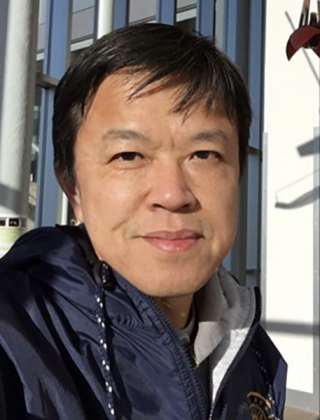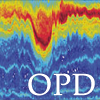
|
Barry Ma Senior Oceanographer binbing@uw.edu Phone 206-221-4720 |
Education
B.S., ROC Naval Academy, Kaohsiung, Taiwan, 1988
M.S. Physical Oceanography, US Naval Postgraduate School, 1998
Ph.D. Oceanography, University of Washington, 2004
|
Publications |
2000-present and while at APL-UW |
Validation of surface wave spectral measurements from velocity profiling floats Stadler, J., J. Girton, and B. Ma, "Validation of surface wave spectral measurements from velocity profiling floats," J. Atmos. Ocean. Technol., 42, 449-462, doi:10.1175/JTECH-D-24-0023.1, 2025. |
More Info |
1 May 2025 |
|||||||
|
EM-APEX floats have primarily been used to measure subsurface ocean velocities for the purpose of studying ocean dynamics and the vertical structure and shear of currents. However, the motionally-induced voltage sensed by the EM-APEX also contains signals from surface wave orbital velocities, and the time taken to pass through the top ~100 m of the water column is sufficient to estimate a spectrum of surface wave amplitudes with periods from 5–20 seconds (i.e., including both wind seas and long swell) with each profile. Following procedures developed by Hsu (2021) and D'Asaro (2015) we analyzed the performance of EM-APEX float measurements of surface-wave spectra, as well as bulk wave parameters such as significant wave height and energy period, against other in-situ wave-measuring platforms during a 2017 field study off the coast of California (ONR's Langmuir Circulation Department Research Initiative, or LC-DRI). We discuss the limitations and uncertainties inherent in the EM-APEX wave measurements, and determine the uncertainty on each individual 1Hz velocity measurement to be on the order of 1.6 cm/s, resulting in a minimal detectable significant wave height of Hs = 0.6 m. Results indicate that the EM-APEX surface wave spectral measurements are in good agreement with the other in-situ wave measurements, with correlation coefficients of R2 = 0.76 for significant wave height, and R2 = 0.65 for energy period. This work demonstrates the potential for these floats to be used as a useful tool in future direct measurements of surface-wave driven mixing processes, Langmuir turbulence, and the interactions between surface waves and ocean currents. |
|||||||||
Passive acoustic environment in Kao-Ping submarine canyon at the southwest of Taiwan Chen, J., B.B. Ma, Y.-J. Yang, and L. Chiu, "Passive acoustic environment in Kao-Ping submarine canyon at the southwest of Taiwan," In Proc., OCEANS 2024, 15-18 April, Singapore, doi:10.1109/OCEANS51537.2024.10752611 (IEEE, 2024). |
More Info |
15 Nov 2024 |
|||||||
|
The Kao-Ping Submarine Canyon (KPSC) located in southwest Taiwan which has abundant shellfish supporting nearby fishing activities at Donggang township. There are ferries en route to and from Liuqui island, mostly for tourist activities. The submarine canyon traps suspended fine-grained sediments morphologically with episodic large river discharges after intensive rainfall triggered by tropical storms. Various biophony, geophony, and anthrophony sound sources make it a unique location for studying the acoustic environment in the submarine canyon. We deployed a subsurface mooring equipped with a passive acoustic array, Acoustic Doppler Current Profilers (ADCPs), Conductivity-Temperature-Depth (CTD) sensor, and turbidity sensors at the depth ~350 meters along the thalweg line for a period of three weeks. The acoustic array comprises four hydrophones configured as a vertical line array. Each hydrophone is precisely spaced 30 cm apart with a sampling rate of 64 kHz. The ancillary data collected includes meteorological data from a surface buoy nearby. Acoustic array data is analyzed using an unsupervised machine learning program. Utilizing cluster analysis, the audio data is grouped into distinct regions characterized by either high or low frequencies. Preliminary findings indicate that the ambient noise spectrum is primarily dominated by episodic ferry noises throughout the day. During the night, the acoustic spectra in the low-frequency band (< 3 kHz) shift to biological sources. Detecting and classifying other geophony sources such as wind, rain, and hyperpycnal flows prove to be challenging due to the dominance of strong anthropogenic sources in the region. A detailed statistical description of the ambient noise content will be presented based on the data collected. |
|||||||||
Energetic stratified turbulence generated by Kuroshio–seamount interactions in Tokara Strait Takahashi, A., R.C. Lien, E. Kunze, B. Ma, H. Nakamura, A. Nishina, E. Tsutsumi, R. Inoue, T. Nagai, and T. Endoh, "Energetic stratified turbulence generated by Kuroshio–seamount interactions in Tokara Strait," J. Phys. Oceanogr., 54, 461-484, doi:10.1175/JPO-D-22-0242.1, 2024. |
More Info |
1 Feb 2024 |
|||||||
|
Generating mechanisms and parameterizations for enhanced turbulence in the wake of a seamount in the path of the Kuroshio are investigated. Full-depth profiles of finescale temperature, salinity, horizontal velocity, and microscale thermal-variance dissipation rate up- and downstream of the ~10-km-wide seamount were measured with EM-APEX profiling floats and ADCP moorings. Energetic turbulent kinetic energy dissipation rates and diapycnal diffusivities above the seamount flanks extend at least 20 km downstream. This extended turbulent wake length is inconsistent with isotropic turbulence, which is expected to decay in less than 100 m based on turbulence decay time of N-1 ~100 s and the 0.5 m s-1 Kuroshio flow speed. Thus, the turbulent wake must be maintained by continuous replenishment which might arise from (i) nonlinear instability of a marginally unstable vortex wake, (ii) anisotropic stratified turbulence with expected downstream decay scales of 10–100 km, and/or (iii) lee-wave critical-layer trapping at the base of the Kuroshio. Three turbulence parameterizations operating on different scales, (i) finescale, (ii) large-eddy, and (iii) reduced-shear, are tested. Average ε vertical profiles are well reproduced by all three parameterizations. Vertical wavenumber spectra for shear and strain are saturated over 10–100 m vertical wavelengths comparable to water depth with spectral levels independent of ε and spectral slopes of –1, indicating that the wake flows are strongly nonlinear. In contrast, vertical divergence spectral levels increase with ε. |
|||||||||






